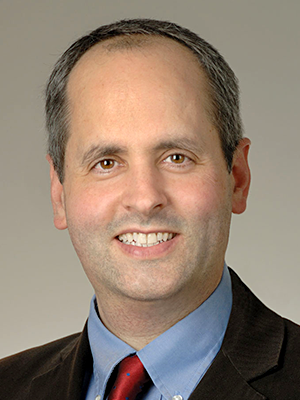The Molecular Mechanics of Eukaryotic Translation Initiation
- Jon Lorsch,
PhD, Chief, Section on the Mechanism and Regulation of Protein Synthesis - Fujun Zhou, PhD, Research Fellow
- Meizhen Hou, MS, Biologist
- Julie Bocetti, BA, Postbaccalaureate Intramural Research Training Award Fellow

The goal of our research is to elucidate the molecular mechanisms underlying the initiation phase of protein synthesis in eukaryotic organisms. We use the yeast Saccharomyces cerevisiae as a model system and employ a range of approaches, from genetics to biochemistry to structural biology, in collaboration with Alan Hinnebusch's and Tom Dever’s labs and several other research groups around the world.
Eukaryotic translation initiation is a key control point in the regulation of gene expression. It begins when an initiator methionyl tRNA (Met-tRNAi) is loaded onto the small (40S) ribosomal subunit. Met-tRNAi binds to the 40S subunit as a ternary complex (TC) with the GTP–bound form of the initiation factor eIF2. Three other factors, eIF1, eIF1A, and eIF3, also bind to the 40S subunit and promote the loading of the TC. The resulting 43S preinitiation complex (PIC) is then loaded onto the 5′ end of an mRNA with the aid of eIF3 and the eIF4 group of factors: the RNA helicase eIF4A; the 5′ 7-methylguanosine cap-binding protein eIF4E; the scaffolding protein eIF4G; and the 40S subunit– and RNA–binding protein eIF4B. Both eIF4A and eIF4E bind to eIF4G and form the eIF4F complex. Once loaded onto the mRNA, the 43S PIC is thought to scan the mRNA in search of an AUG start codon. The process is ATP–dependent and likely requires several RNA helicases, including the DEAD–box protein Ded1p. Recognition of the start site begins with base pairing between the anticodon of tRNAi and the AUG codon. Base pairing then triggers downstream events that commit the PIC to continuing initiation from that point on the mRNA, events that include ejection of eIF1 from its binding site on the 40S subunit, movement of the C-terminal tail (CTT) of eIF1A, and release of phosphate from eIF2, which converts eIF2 to its GDP–bound state. In addition, the initiator tRNA moves from a position that is not fully engaged in the ribosomal P site [termed P(OUT)] to one that is [P(IN)], and the PIC as a whole converts from an open conformation, which is conducive to scanning, to a closed one, which is not. At this stage, eIF2•GDP dissociates from the PIC, and eIF1A and a second GTPase factor, eIF5B, coordinate joining of the large ribosomal subunit to form the 80S initiation complex. In a process that appears to result in conformational reorganization of the complex, eIF5B hydrolyzes GTP and then dissociates along with eIF1A.
We have continued our studies of translation initiation using the massively parallel, transcriptome-wide system called Rec-Seq that we have developed over the last few years. Rec-Seq utilizes our fully reconstituted yeast translation-initiation system and is able to simultaneously monitor the recruitment of each mRNA in the yeast transcriptome to the 43S ribosomal PIC. Using this system, we showed that the yeast DEAD–box RNA helicase Ded1 promotes recruitment of mRNAs with long, structured 5′-UTRs, whereas the related translation initiation factor eIF4A is required for efficient recruitment of essentially all yeast mRNAs [Reference 1]. We have been focusing on experiments to determine how mRNA features and the abundance of different translation components interact to control the rates of translation initiation on specific mRNAs. Our results appear to support a previously proposed model that limiting 40S subunit concentrations specifically disfavors translation of “weak” mRNAs that compete poorly for binding to the PIC, compared with “strong,” more competitive mRNAs. mRNA 5'–UTR length and structure are important determinants for whether an mRNA is weak or strong. We are also probing the effects of changing the ratios of mRNA to 40S subunits and the concentration of the mRNA cap-binding complex eIF4E–eIF4G. In addition, we are extending our studies to examine how mRNA features, translation-component abundance and specific initiation-factor mutations alter the fidelity of translation initiation-site selection, studies that should illuminate important mechanisms of translational control.
Additional Funding
- Funding is provided via a Memorandum of Understanding (MOU) between NIGMS and NICHD.
Publications
- Transcriptome-wide analysis of the function of Ded1 in translation preinitiation complex assembly in a reconstituted in vitro system. Elife 2024 13:RP93255
Collaborators
- Thomas Dever, PhD, Section on Protein Biosynthesis, NICHD, Bethesda, MD
- Alan Hinnebusch, PhD, Section on Nutrient Control of Gene Expression, NICHD, Bethesda, MD
- Venki Ramakrishnan, PhD, MRC Laboratory of Molecular Biology, Cambridge, United Kingdom
Contact
For more information, email jon.lorsch@nih.gov or visit https://irp.nih.gov/pi/jon-lorsch.

